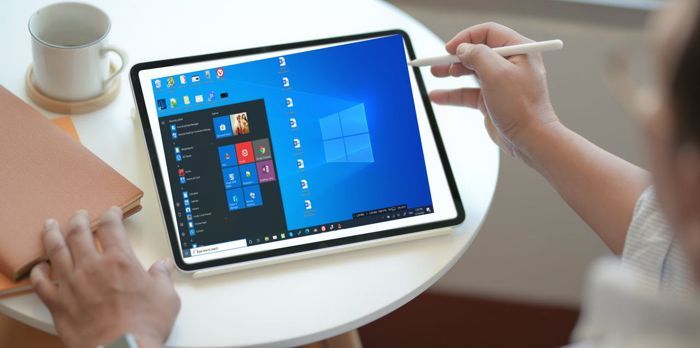If your computer comes with a touch screen functionality, it is enabled by default. You can disable touch screen feature if you don’t need it. It will save your battery power and some extra memory resources.
Nowadays, a lot of laptops come with a touch screen display and Windows 10. This gives the best of both worlds as you can use both the touch screen like in a tablet and a keyboard/mouse on a laptop.
Table of Contents
Why disable or turn off touch screen in Windows 10?
While there are certain advantages of a touch-enabled display, there are times when you would like to simply turn off touch screen in Windows 10. Some scenarios include the following:
- You have damaged the laptop LCD and the touch screen is actually interfering in your work.
- You want to boost the battery life of your system.
- It’s a good idea to disable touch screen in Windows 10 while you are presenting something and may end up messing up your presentation by touching on the wrong slide.
- The computer is having a ghost touch or phantom touch problems.
A ghost touch or phantom touch is an event when the touch screen reacts as if it has been touched by an invisible finger or stylus. This can be caused by a hardware issue or even a dirty screen.
How to disable touch screen in Windows 10
There are two ways to disable or turn off the touch screen in Windows 10. We will discuss both of them here:
Disable touch screen using Device Manager
To turn off the touch screen immediately but temporarily, you can disable the touch screen device from the Device Manager. Here is how:
- Open the Device Manager (Windows key + X + M)
- Expand Human Interface Devices
- Right-click HID-compliant touch screen
- Select Disable

To enable the touch screen again:
- Open the Device Manager (Windows key + X + M)
- Expand Human Interface Devices
- Right-click HID-compliant touch screen
- Select Enable.
Many people complain that this method only works temporarily and the touch screen is enabled again when they restart the system. If you want to permanently disable the touch screen, please follow the next method.
Permanently Disable touch screen using Windows Registry
If you want to permanently disable touch screen in Windows 10, you should follow the steps below:
- Open Windows Registry Editor (Run –> regedit)
- Go to the following registry key:
Computer\HKEY_CURRENT_USER\Software\Microsoft\Wisp\Touch - In the right-hand pane, create a new DWORD 32-bit entry with the name TouchGate.
- Make sure the value of this entry is 0.

- Restart the system.
The touch screen will stop working after restart. If you want to enable the touch screen again, change the TouchGate value from 0 to 1 or simply delete the TouchGate entry.
If you are using Microsoft Surface laptop and your touch screen is not working, you can follow this guide from Microsoft to troubleshoot your touch screen issues.
Does this article help you in disabling the touch screen of your device? If yes then which method did you use? What are your overall experiences with Windows 10 touch screen or tablet mode?






5 comments
Sara
This worked for me thank you so much sir
SSS
Both have been done on a Lenovo and after Windows updates I am back to square one, it’s re-enabled in Device Manager which seems to overrule the registry.
Jules Lapprand
I have followed the steps to permanently disable the touchscreen in the registry editor, but the phantom screen clicks come up outside of windows. Every time I turn on the computer or restart it, before logging in to windows, I have “phantom touches” all over the place.
This is especially bad when the computer is performing necessary updates. The phantom clicks go crazy, and I feel it seriously slows down Windows updates. Full control comes back when I manage to log back in to Windows.
I am now trying to put all values in the “Touch” folder of the registry editor under “Wisp” to zero, not just “Touchgate.” I will see if that makes a difference.
Sean Pettit
This will get the job done via elevated PowerShell:
Get-PnpDevice | Where-Object {$_.FriendlyName -like ‘*touch screen*’} | Disable-PnpDevice -Confirm:$false
Boris Ashman
You can disable TouchScreen via Device Manager – which helps. But it will be restored after reboot, and if you have cracked touch screen, it is not even guranteed you could get to device manager with all these phantom screen click produced by the cracks.
To disable it permanently, you’d have to edit Windows Registry via regedit. Thankfully, I found the the final solution here: https://answers.microsoft.com/en-us/windows/forum/windows_10-hardware/permanently-disable-touchscreen-in-windows-10/35c516b0-21c1-4671-8782-530ec118473d?tm=1520408734977):
1. Open regedit
2. Navigate to HKEY_CURRENT_USER\Software\Microsoft\Wisp\Touch
3. Create a new DWORD (32 bit) with the name TouchGate
4. Doubleclik on the newly ceated DWORD and make sure it has the value 0
(0 = touch disabled, 1 = touch enabled)
After rebooting the touch functionality should be disabled permanently and therefore your problem solved